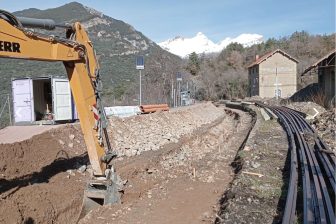‘Introduction of Performance-based Maintenance has disrupted old working methods’
The introduction of Performance-based Maintenance has disrupted old working methods, which has stimulated smart track maintenance. Consequently, the number of defects per year has decreased or has been reduced by approximately fifteen percent , and there has been an eight percent drop in hindrance for trains. Costs have also fallen considerably, reports ProRail’s Asset Management Programme Director Paul Carstens. On March 30th, together with ProRail’s Maintenance Procurement Manager Adrie Koster, Carstens will give a presentation on Performance-based Maintenance at RailTech Europe.
ProRail outsources minor maintenance of the track infrastructure. This is the day-to-day maintenance, and is different to major maintenance jobs that are part of renovations and construction. Minor maintenance work is done using Output Process Contracts (OPC) and contracts for Performance-based Maintenance (PBM). With the OPCs, ProRail outsources the maintenance activities to track contractors. With PBM contracts, the focus is on performance, which gives the contractor more freedom to achieve the desired results by applying their own methods, and thus greater incentives to innovate.
“This is a big transition for us, but also for the contractors. Instead of just doing the work, they are stimulated to carry out smart maintenance. This also requires us to have a different approach at ProRail. We have to show that we trust the contactors, and encourage innovation.”
Transition
“The transition to Performance-based Maintenance has disrupted old working methods. For example, contractors are thinking whether they can combine maintenance of the hedges and embankments with other tasks. In addition, preventative maintenance is rewarded by using a bonus and penalty system. Defects are always a pain, because if something suddenly goes wrong it is the train users that suffer. Preventing defects is much better.”
Figures from ProRail also show that the function repair time, which is the time required to fix a defect, is about twenty per cent shorter with a PBM contract. Currently, maintenance is done according to the PBM method in 13 out of 21 regions.
Outsourced track maintenance
“In 2008, we faced three big issues in the Netherlands. We needed more of a handle on the external operational status, there were many defects in the Schiphol Tunnel, and there were a lot of problems with minor maintenance tasks done in a non-compliant fashion. Things were getting more costly every year, yet performance was not improving. A European benchmark showed that we were one of the most expensive countries in terms of minor track maintenance.”
“At that time, we decided to outsource, and to no longer talk in terms of input and activities, but about performance. Prior to that it was as if we had a checklist to check if a switch had been greased twelve times. In the new model, we look at whether the annual numbers of defects in a given region has fallen.”
Maintenance regions
We divided the Dutch railway network into 21 regions, so that they were a suitable size for the contractors. Next, there was a big transition from OPCs to PBM contracts. We realised that before we could do this we had to sort out a number of other things. We had to organise our data in such a way that we could provide it when we put the work out to tender, which is why we started the SpoorData programme.”
“Additionally, we had to make a transformation in terms of knowledge, training and expertise. We needed to inform our staff about what PBM contracts look like and how roles are divided. Therefore we began basic training to teach all our staff to work in a different way. This is about halfway to completion. We have made a substantial improvement in data and have trained very many people.”
Lifetime of track
“A PBM contract is set out in such a way that it not only ensures a safer track, but also a sustainable one. For example, we make demands about how a section of track must be laid and what canting must be used. By carefully formulating the sustainability requirements, the track will last longer. This way of working is very innovative; it has never been done in such a way on other countries’ railways.”
“Additionally, we use measuring trains to record how the track has been laid. Measuring apparatus on passenger trains can map out the value of the track. We can pass this information on to the contractors, as they are the experts. They know better than anyone else precisely how to carry out and optimise external maintenance.”
Rejection norms for track components
A number of aspects of PBM still need improvement. For instance, the system norms for track components are being developed further. With these, ProRail can assess the state of the components and determine whether immediate action is required or if regular maintenance suffices. If something needs to be immediately remedied, ProRail issues a code red and trains are stopped from running.
“For a number of vital components we did not have a critical minimum. This is a point where it is no longer safe to run trains on the tracks. Now we have introduced an absolute minimum, and are working on updating our system norms to bring them in line with European guidelines.”
On March 30th, during an international rail conference about rail maintenance, Paul Carstens and Adrie Koster will give a presentation on Performance-based Maintenance in the Netherlands. The three-day conference is part of RailTech Europe, which is taking place on 28-30 March in the Jaarbeurs in Utrecht, Netherlands. For more info, please visit the conference website: https://www.railtech.com/railtech-2017/conference/



